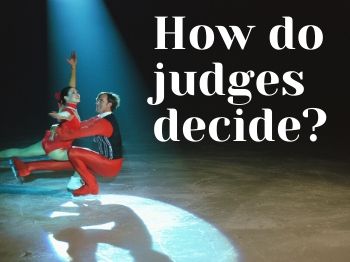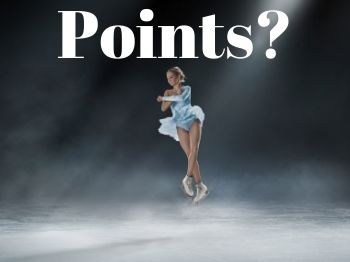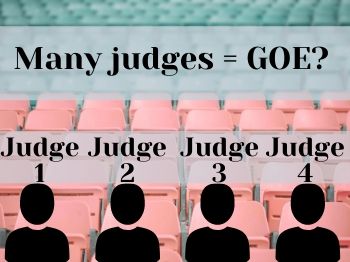So you have recently been in a figure skating competition and want to understand the scores. Or you are watching it on T.V and are wondering, what is GOE in figure skating. What exactly does the Grade of execution mean and how is it marked?
Well to put it at its most simple, its how well a particular element has been performed. Has an element been performed in an amazing way, with a little ‘va va voom’, or was it standard? Did it fall below what the judges were expecting to see? This will all effect the score when it come to the GOE, the grade of execution. There are many factors that influence the GOE, as we will see.

class="wp-block-heading" id="so-what-is-the-geo-grade-of-execution-exactly">So what is the GEO (Grade of Execution) exactly?
When a judge watches you skate and element, lets say for instance,,,,,, a spin. The judges are looking to award points regarding how well you performed it. They might also reduce your mark if your spin wasn’t that good.

How do judges decide whether your GOE is any good?
So how do they decide whether your element, in this case a spin, was any good or not? Well they don’t just start plucking numbers out of the air. No, no, no. There are some pretty hefty rules on how you award points for GOE.
How are GOE points decided in figure skating?
Well there are two sides to this coin. A judge can award points or take them away (these are called reductions).

How are GOE points awarded?
Points are given according to how many bullets you have covered for that particular element. What do I mean by bullets? Well, you know when you make a list and you put a bullet point point on each item on the list to make it stand out? Yeah, well that’s what the IJS (International Judging System) does.
There are lists of bullets for each and every element in figure skating. So, before we were talking about our hypothetical spin. Well lets imagine the judge has seen the spin. Now the judge has to decide, how many bullets did our spin hit.
(Link to Amazon, commission earned)
Examples of bullets for a spin
So now the judge has seen your spin, they are going to ask themselves, what bullet points did the spin hit? They will consider the following:
- Good speed and acceleration through the spin
- Good, controlled, clear positions
- Effortless throughout
- Maintaining a centered spin
So for every one of these bullets you will get a point towards your GOE score.

How are points taken off you (Reductions)
Well just like there are bullets for giving you points, there are bullets for taking them away. Going back to our fictitious spin, here are some of the bullets that would loose you points.
- Travelling -1 to -3
- Touch down with foot or hand -1 to -3
- Poor, awkward positions -1 to -3
- Slow, loss of speed -1 – -3
This doesn’t just go for solo free skating, there are additions and reductions for all of the areas of figure skating. For example in ice dance, you could get a reduction in GOE for:
- Stumble -2
- Loss of balance -1
- Element does not reflect the character of the chosen rhythm -1 to -2
- Poor execution, labored, uncontrolled -1 to -2
(Link to Amazon, commission earned)
How is the GOE judged for different disciplines of figure skating?
Well, all disciplines are not the same. Quite simply put, judjes have different criteria to judge by for elements performed in different disciplines.
A judge will use a different set of criteria to judge a single skating spin than it would to judge a spin performed by two skaters in ice dance.
How is the GOE judged for ice dance?
Ice dance has a particular criteria for judging GOE under the +5 to -5 system. The video below explains in detail how the GEO for ice dance is judged. The video below is issued by the ISU (International Skating Union).
How is the GOE judged for single figure skating?
Again there are different criteria for the judging of GOE for single skating. Rather than plow through pages of documents, this video from the ISU (International Skating Union) will give you a good idea of what judges are looking for.
How is the GOE judged for pair figure skating
Pair skaters will also have a different set of criteria for judging of the GOE. Again the the ISU have kindly created a video explaining the judging of GOE for pair skaters under the +5 to -5 marking system.
How is the GOE calculated for figure skating?
There are two factors for the calculation of GOE after the judges have decided how many bullets your element did or did not meet. The first factor is the SOV (scale of values), the other is the mathematics that is used to calculate the final GOE score for that element.
How does the SOV (scale of values) affect the GOE (Grade of execution)
So you thought you had got it up until here right? Then I mentioned the SOV (Scale of Values) and it all got confusing again right?
The scale of values doesn’t change the GOE. If you skated an element well and got a good GOE, then that is that. The SOV (Scale of Values) won’t change that. It just decides how many points are awarded in terms of how hard the element was.
Don’t worry. The scale of values is a chart. Each element has a base value, how much is worth in terms of points. The harder it is to perform, the more points it earns. The easier an element is to perform, the lower the value. For example, a single axle jump has a lower value than a double axle.
On the chart are areas for the different levels of GOE. The chart provides a numerical representation of how hard the element was and how well it was performed. The GOE value is added to the base value, this gives you your score for the element. If the GOE is low, it will take away from the base score. If the GOE is high it will add to the base scare.
Here is an example of how SOV works
| -5 | -4 | -3 | -2 | -1 | Base | +1 | +2 | +3 | +4 | +5 | |
| -50% | -40% | -30% | -20% | -10% | +10% | +20% | +30% | +40% | +50% | ||
| Jumps | |||||||||||
| 1T | -0.20 | -0.16 | -0.12 | -0.08 | -0.04 | 0.40 | +0.04 | +0.08 | +0.12 | +0.16 | +0.20 |
The above table is an excerpt from the single and pair skating table of values 2019. From it you can see the element (1T) which is a single toe loop.
You can see from the table, that the base value is 0.40, so this jump is worth 0.40. The GOE is labeled across the top -5 to +5. So you can see that if you had a GOE of +1, that would increase your base score by +0.04, added to the base score of 0.40 gives you 0.44 for the jump.
If you would like to have a look at what a SOV (Scale of values chart) looks like. Here is one issued by the ISU for pair and single skating.

How the GOE is calculated across several judges
So once all of the judges have given you a mark for your element. They are converted using the SOV (Scale of Values) to points. Then there is a bit of mathematics. Lets say there are nine judges. They take the trimmed average/trimmed mean. That means that they disregard the highest and the lowest scores and take the mean average of the scores that remain.
(Link to Amazon, commission earned)
How does the GOE affect the technical score in figure skating
O.K, so in the IJS (International Judging System) your segment score (which is total score for that single performance) is made up of a technical element score (TES) and a program component score (PCS) added together.
The technical element score is made up of points given or reduced by the judges according to how well that element was skated. How well the element is skated is the GOE (Grade of Execution).
The technical score (TES) is calculated from the GOE (Grade of Execution). So the GOE is very important in terms of what your technical score is going to be. Why? Because the technical score is calculated from the GOE score.
If you liked this article then you might enjoy the article ‘How to prepare for an ice skating test’
Preparing early for an ice skating test can be the key to success. Allocating extra time for practice nearer the test, learning your program and knowing when to rest are just a few of the tips explored in this article that you can click here to read.

